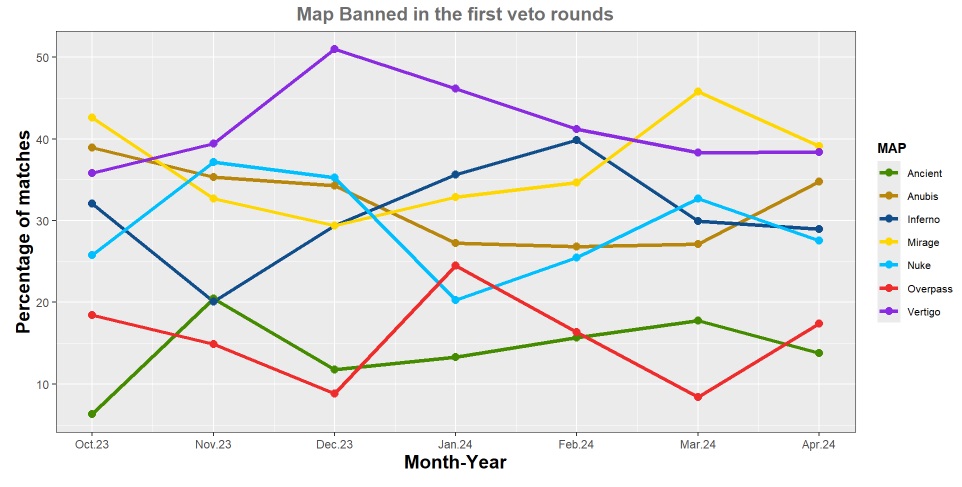BFN Lab: Insights and Innovations
Explore the latest trends and insights in technology, science, and innovation at BFN Lab.
Map Veto Wars: The Strategy You Didn't Know You Needed in CS2
Unlock the secrets of Map Veto Wars in CS2! Discover strategic tips and tricks that can turn the tide in your next match.
Mastering Map Veto: Essential Strategies for Competitive CS2
In the fast-paced world of competitive CS2, mastering map veto is crucial for any team looking to gain an edge over their opponents. The map veto process sets the stage for the match, and understanding the nuances can significantly impact your chances of victory. Start by analyzing your team's strengths and weaknesses across different maps. Create a strategic map pool that highlights your best performances. Utilize tools such as heat maps and past game statistics to inform your decisions. Remember, a well-thought-out veto can force your opponents into uncomfortable territory, allowing you to capitalize on their weaknesses.
Moreover, communication during the veto process is vital. Engage in discussions with your team to ensure everyone is on the same page regarding the map selections. Consider using the following essential strategies during the veto:
- Prioritize your best maps: Always veto maps where your team performs poorly.
- Research your opponents: Understand their map preferences and tendencies.
- Maintain flexibility: Be prepared to adapt your strategy based on the opposing team's veto.
By implementing these strategies, your team will not only improve its map vetting skills but also enhance overall performance in competitive CS2 matches.

Counter-Strike is a popular first-person shooter game that emphasizes teamwork, strategy, and skill. Players can compete in various game modes, and one common issue players face is when their match demo has expired cs2, limiting their ability to review past performances and learn from them.
The Psychology Behind Map Veto Decisions in CS2
The psychology behind map veto decisions in CS2 is a fascinating blend of strategy and personal preference. Players often find themselves faced with a selection of maps that can greatly influence the outcome of a match. Understanding which maps tend to favor specific gameplay styles can lead to informed decisions. For instance, choosing to veto a map like Dust II might stem from a team's struggle with its long sightlines, while opting out of Inferno might be due to a lack of comfort in fighting for control over tight choke points. These strategic decisions are deeply rooted in each player’s experiences, abilities, and the group's overall synergy, showcasing the importance of psychological factors in the competitive arena.
Moreover, the decision-making process during map vetoes often reflects the team’s confidence and mindset. A team that has had positive experiences on a particular map may choose to include it, while those struggling with defeat might express a psychological need to avoid it. This tendency can reveal deeper issues, such as the fear of failure or the pressure to perform. Understanding these psychological dynamics not only aids players in making better choices during the veto phase but also enhances their overall mental approach in competitive settings. By analyzing the underlying reasons behind these decisions, players can develop stronger strategies and improve their overall performance.
How to Use Map Veto to Outplay Your Opponents in CS2
In CS2, mastering the art of map veto can significantly enhance your gameplay and provide a strategic edge over your opponents. To begin with, understanding the map pool is crucial. Familiarize yourself with each map's strengths and weaknesses, and assess your team's proficiency on them. Start your veto process by eliminating the maps that favor your opponent’s style of play. For example, if they excel on close-quarters maps, it may be wise to remove those first. This initial step sets the stage for choosing a map where your team can dominate.
Next, after the initial bans, focus on selecting a map that complements your team’s strengths. Utilize the information gathered from previous matches and practice sessions to make an informed choice. Creating a strong synergy with your teammates is vital; consider discussing strategies for the selected map. Furthermore, if the match allows, always save your veto for the very last map, as it can be a decisive factor in disrupting the opponent's rhythm. By effectively employing map veto tactics, you can significantly increase your chances of outplaying your opponents and securing victory.